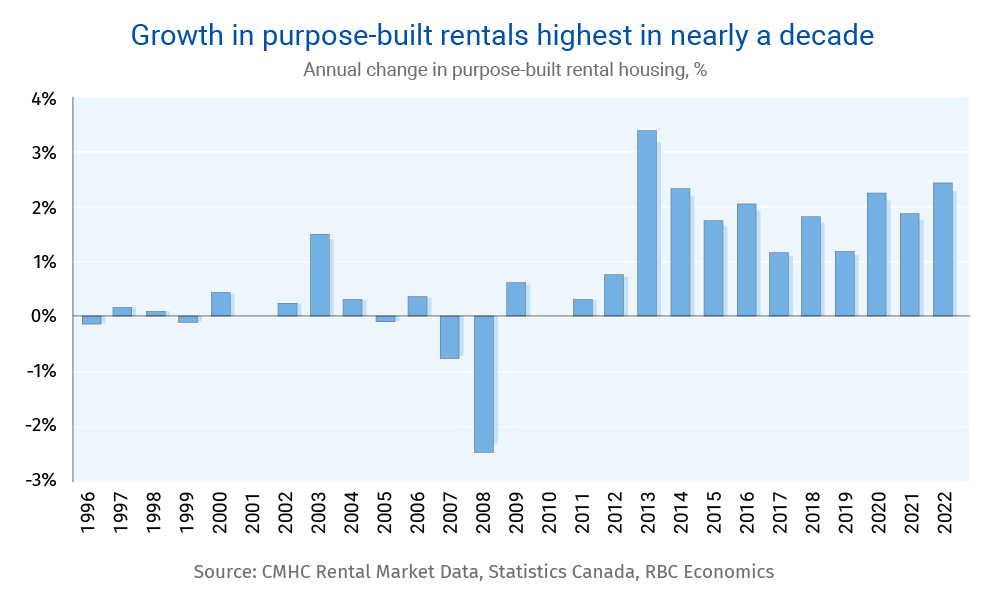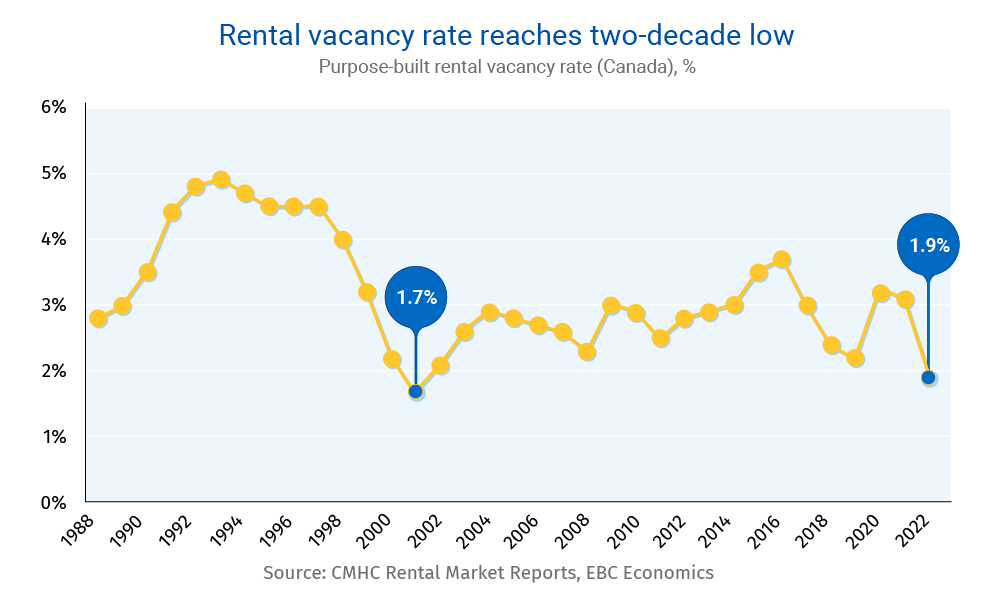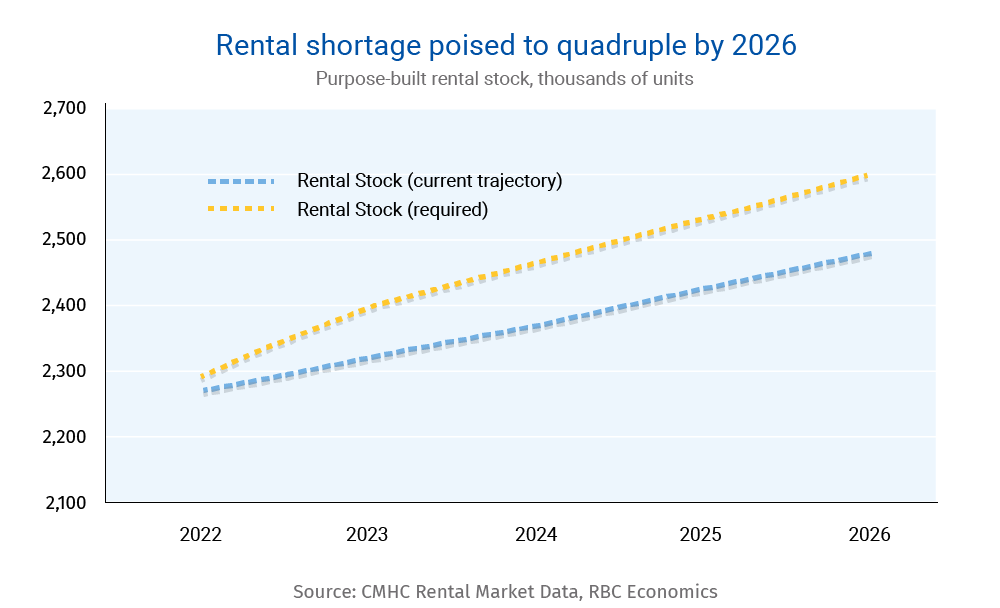- Last year, Canada’s purpose-built rental housing stock grew at its fastest pace since 2014.
- Vacancy rates nevertheless fell to a two-decade low as high levels of in-migration and the loss of housing affordability sparked a record surge in both demand and rents.
- Toronto and Montreal—cities likely to see the sharpest increases in demand due to immigration—experienced the smallest expansions in supply among major Canadian cities.
- With Canada’s immigration targets set at record levels and affordability poised to remain stretched, the pressure isn’t likely to let up.
- The bottom line: Without a significant boost in rental stock, Canada’s rental housing gap could exceed 120,000 by 2026—quadrupling the current deficit. This will tip the housing market into a greater state of imbalance and drive the optimal vacancy rate of 3% even further out of reach.
Canada built a record number of apartments last year
Canada’s stock of rental housing boomed in 2022, growing at 2.4%—the fastest pace since 2014. That boost has never been needed more. With affordability challenges pushing home ownership rates to a 30-year low and annual federal immigration targets set to grow 8% by 2025, strong demand for rented accommodation is unlikely to ease.
The growth in supply has been uneven across the country. Among Canada’s six largest CMAs, the biggest gains in purpose-built rental stock were in Calgary (+7.4%) and Ottawa-Gatineau (+5.5%). The smallest percentage increases were in Canada’s most populous cities—Toronto (+2.1) and Montreal (+1.4%). The latter urban centres are among the most popular destinations for newcomers, welcoming an estimated 32% and 10% of international immigrants respectively last year. The slow growth in rentals in these cities will be especially problematic as demand for rented accommodation continues to outgrow supply.

Fierce demand drove record rent increases
Indeed, even with last year’s sizeable expansion, Canada’s current purpose-built rental stock is struggling to keep up with demand. The vacancy rate in this category plunged to its lowest point in 21 years in 2022, dipping to just 1.9%. The total decline—120 basis points in just 12 months—represented the steepest single year decrease in more than three decades. And relentless competition for units drove the highest annual increase in rent growth on record. Overall, rent growth for a 2-bedroom purpose-built unit rose 5.6% with jumps in Gatineau (+9.1%), Toronto (+6.5%) and Calgary (+6.0%) among the highest in Canada last year.
And that isn’t the worst of it. A closer look at the rental condo market in some of Canada’s larger cities reveals an even tighter squeeze. Condo rental vacancy rates in Ottawa-Gatineau (0.7%), Toronto (1.1%), and Calgary (1.8%) are among the lowest in the country—suggesting intense competition that will only add pressure to rents.
The rapid absorption of these new units highlights the severity of the “rental housing gap”—that is, the difference between the projected rental stock at the current rate of increase and the rental stock required to achieve balance (or a 3% vacancy rate) while keeping up with future demand. It also demonstrates the blistering speed at which the appetite for rented accommodation is growing. With high levels of in-migration and a widespread shift to rental housing continuing due to affordability struggles, we don’t see Canada returning to that optimal 3% vacancy rate without a significant acceleration in supply.

Canada could be short more than 120,000 rental units by 2026
We estimate there is already a 25,000—30,000-unit deficit in Canada’s purpose-built rental stock. This shortfall is likely to grow exponentially over the next four years as demand soars.
By 2026, the rental housing gap could reach more than 120,000 units, nearly four times the estimated shortfall today. Canada will need to add 332,000 units to its current rental stock between now and then to achieve a balanced market with rent stability. That would represent roughly a 20% increase in the annual pace of construction achieved in 2022 (when 70,000 rental units were completed).
Turning condo units into rentals, converting commercial buildings and adding rental suites to existing homes would certainly help ease the pressure. But these responses are unlikely to be enough. The best way to meet current and future demand, as well as provide stability (and hopefully greater affordability) in the rental market is to considerably grow the supply of purpose-built rentals.

Robert Hogue is responsible for providing analysis and forecasts on the Canadian housing market and provincial economies. Robert holds a Master’s degree in economics from Queen’s University and a Bachelor’s degree from Université de Montréal. He joined RBC in 2008.
Rachel Battaglia is an economist at RBC. She is a member of the Macro and Regional Analysis Group, providing analysis for the provincial macroeconomic outlook.
Proof Point is edited by Edited by Naomi Powell, Managing Editor of RBC Economics & Thought Leadership.
This article is intended as general information only and is not to be relied upon as constituting legal, financial or other professional advice. A professional advisor should be consulted regarding your specific situation. Information presented is believed to be factual and up-to-date but we do not guarantee its accuracy and it should not be regarded as a complete analysis of the subjects discussed. All expressions of opinion reflect the judgment of the authors as of the date of publication and are subject to change. No endorsement of any third parties or their advice, opinions, information, products or services is expressly given or implied by Royal Bank of Canada or any of its affiliates.


 Learn More
Learn More